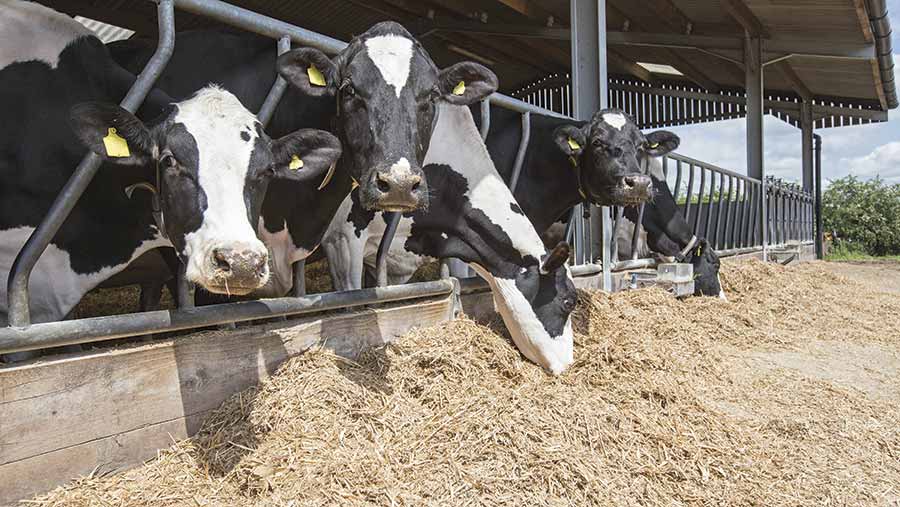How to feed dry cows to prevent negative protein balance
 © Tim Scrivener
© Tim Scrivener Feeding adequate metabolisable protein and amino acids at calving is essential in order to prevent negative protein balance – something that is just as common as negative energy balance.
According to Jim Drackley, professor of animal science at the University of Illinois, and Mole Valley Feed Solutions’ head of nutrition, Chris Bartram, protein deficiency is an area that needs to be brought into sharp focus.
Dr Bartram said: “For the past 25 years, we have talked about negative energy balance in early lactation. I would suggest we now need to think about negative metabolisable protein balance.”
See also: How to prevent negative energy balance in dairy cows
Speaking at the recent Mole Valley Farmers Lifetime Dairy Conference at Wincanton Racecourse, Somerset, Dr Drackley highlighted the fact that protein consumption generally falls short of requirements around calving, forcing the cow to mobilise body reserves in the first week postpartum.
This adds to immune suppression at this time, as protein and amino acids are essential for immunity.
However, some of the main issues occur when a cow is forced to mobilise body protein before calving, when dietary protein supply is inadequate.
“We don’t want cows to break down muscle protein before calving as there is then less protein available after calving,” explained Dr Drackley.
Ketosis risk
He also said trial work had shown that cows that mobilised more protein pre-calving were more likely to develop ketosis.
To overcome these issues, he said it was vital to provide cows with sufficient metabolisable protein around calving – specifically for the amino acids it provided.
Providing methionine and lysine is particularly important, as it is likely these are being underfed in most diets (see “Pre-calving protein recommendations”).
Pre-calving protein recommendations
- >1,200g/day of Metabolisable protein (MP)
- Include some high bypass source of MP
- Consider strategic use of amino acids
- 30g/day of metabolisable methionine
- 90g/day of metabolisable lysine
Benefits of feeding amino acids
Dr Drackley’s own work has shown feeding rumen-protected methionine in the three weeks before calving and 28 days after calving resulted in improved dry matter intakes post-calving, improved milk yields and better milk proteins (see “Effects of feeding different forms of protected methionine on performance”).
Cows also had better immunity, as shown by better-functioning immune cells.
A Mole Valley Farmers trial with Reading University also showed similar benefits. The study looked at the effects of feeding very early-lactation cows a combination of protected methionine, lysine and histidine.
The results showed a benefit of 1.8kg more milk a cow, a 0.16 unit increase in milk protein and a 0.42 unit increase in milk fat.
Dr Bartram concluded: “I suggest you start to look at your transition diets very carefully and try to ensure you’re supplying 1,250g of metabolisable protein. At the same time, think very carefully about the amino acid composition of that protein.”
Effects of feeding different forms of protected methionine on performance |
|||
|
|
Control |
MetaSmart (protected methionine) |
Smartamine (protected methionine) |
|
Milk yield (kg/day) |
35.7 |
38.1 |
40.0 |
|
Milk fat (%) |
4.27 |
4.68 |
4.09 |
|
Milk protein (%) |
3.04 |
3.26 |
3.19 |
|
Milk fat yield (kg/day) |
1.64 |
1.84 |
1.81 |
|
Milk protein yield (kg/day) |
1.11 |
1.23 |
1.24 |
|
Energy corrected milk (kg/day) |
41.0 |
44.8 |
45.0 |
| Source: Osorio et al, 2013. Cows were fed a maize silage based diet with alfalfa, straw and concentrates. Methionine was fed at 5g/cow/day pre-calving and 9-10g/day after calving. | |||
